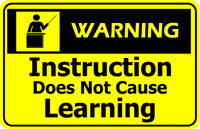Update: If you do not have children in a large, urban school district this post may not make a lot of sense. You are among the lucky.
As someone who has used toilets for many, many years — with little formal training — I feel quite qualified to redesign our nation’s plumbing system to improve the performance issues that I’ve identified.
 (I’m basing this on the recent action of the State Board Of Education in Texas, in their amazing redesign of a curriculum created by professional teachers and learning designers. This is an attitude that I frequently encounter, in which someone who has experienced education feels that that qualifies them to design education for others.)
(I’m basing this on the recent action of the State Board Of Education in Texas, in their amazing redesign of a curriculum created by professional teachers and learning designers. This is an attitude that I frequently encounter, in which someone who has experienced education feels that that qualifies them to design education for others.)
Now you might think that it would make more sense for me to ask a master plumber who has years of training and experience how to handle the waste that flows out of my home. But since I’ve spent so much time on the input side of the equation, I feel perfectly capable of making decisions without consulting one of these so called “plumbing gurus” and just going with my gut. (First of many puns intended.)
My Ten-Point C.R.A.P. Program
With much thought, I’ve developed a Comprehensive Revised Aesthetics Processing (CRAP) program that will deliver a system flush with success and we’ll all come up smelling like roses.
- Your toilet will be assigned a particular plumber based on where you live, regardless of the quality of the plumber. You can petition the local Plumbing Board to allow you to drive your toilet across town to a better plumber every morning, but we won’t pay to put it on a bus.
- If your plumber fails to unclog your toilet over and over, we’ll just move him to another geographic location. Much like the Catholic Church, no matter how deep of a pile of shit he’s in we won’t admit it or take steps to remove him.
- We believe every single toilet is unique — so Plumbing Boards in each community must spend months deciding where to put the “flush” handle, how to connect the water, and whether or not the float is hollow. It would be impossible to have national standards of any kind for toilets. Local communities know better what they need.
- If, over several years, the toilet doesn’t perform well, we’ll just keep asking for more money for purchase of toilets. And complaining that people don’t respect the work that toilets do.
- No toilet can be removed, even if it doesn’t perform at the most basic level. Once installed, it’s there for life. Best we can offer is a “substitute-potty” program where we have specialists come in for huge fees to try to fix the toilet and fail.
- Well over 50% of the budget for Toilet Repair will have to go to “Toilet Administration” — a group of people in nice suits who have never actually installed or used a toilet. They’ll make charts, graphs, and evaluate the plumber as he is on his knees getting his hands dirty.
- If you have several toilets in your house, we will require that you balance the use of each amongst all family members. Just because one is closer, performs better or has less gunfire will not be considered a factor.
- If you complain that your toilet doesn’t perform well, we will fight to the death any attempt to actually measure how well waste passes through. Even though nearly every other profession in the world (from jet pilot to fry cook) is measured on results, we’re special. Plus, it might make the toilet feel bad if we labeled it as “failing” in some way.
- After 25 years, we’ll remove your toilet. But you’ll still have to pay for it every month, along with a generous service allowance and perks. And it’s free to go be a toilet for someone else and get paid twice for taking one load.
- Despite all this, you do have the option of installing your toilet in a “Charter RestRoom” that is sponsored locally for those who demand better performance. You’ll still have to pay all the fees for that traditional toilet you’re not using, and at any time we retain the right to tell you we’re pulling the plug and your successful toilet no longer meets our standards.
Legislation is already in front of Congress (“No Behind Left Behind”) to implement this simple plan, and I encourage you to call your representative to urge them until it passes. If they have trouble passing something of this size, there are aids available.




